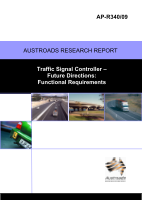Traffic Management

- Publication no: AP-R340-09
- ISBN: 978-1-921551-42-0
- Published: 27 May 2009
- PDF (free) Download
This report includes the examination and recommendation of a five-layer framework to implement controller functions. The key benefit of this concept is the clear demarcation of functions. The proposed concept allows functions to be built logically and progressively. It also allows the controller personality to be separated into various layers.
One of the goals of this proposed project is to allow service modules to be interoperable, therefore allowing more appropriate services to be easily installed to improve the system’s effectiveness in controlling traffic. The second goal is to allow traffic engineers to efficiently select and implement the various services as demanded by the traffic. These two goals are the primary improvements of the proposed system.
- 1. INTRODUCTION AND SCOPE
- 1.1. Identification
- 1.2. Document Overview
- 1.3. System Overview
- 2. REFERENCE DOCUMENTS
- 3. CURRENT CONTROLLER
- 3.1. Roles of Various Organisations
- 3.1.1. Austroads Profile
- 3.1.2. Road/Transport Authorities
- 3.1.3. Equipment/Controller Manufacturers
- 3.2. Controller Structure/Features
- 3.2.1. Controller Architecture
- 3.2.2. Hardware
- 3.2.3. Manufacturer’s Software
- 3.2.4. RTA Software
- 3.3. Modes of Operation
- 3.4. System Implementation
- 3.4.1. Risks
- 3.4.2. Costs
- 3.4.3. Safety/Conflict Management
- 3.4.4. Adaptive Engineering
- 4. JUSTIFICATION FOR AND NATURE OF CHANGE
- 4.1. Research Process
- 4.2. Issues
- 4.2.1. Vehicle-Actuated (VA) Control
- 4.2.2. Conflict Management
- 4.2.3. User Interface
- 4.2.4. Security
- 4.2.5. Adaptive Engineering
- 4.2.6. Performance Management
- 4.3. Changes Considered But Not Included
- Lantern Displays
- Other Outputs
- Controlled I/O Dimensions
- Common Stored Data
- System Control Facilities – Communications Functions
- 5. PROPOSED CONTROLLER
- 5.1. Attributes of a New Controller
- 5.2. Conceptualisation of Traffic Signal Controller Functions
- 5.2.1. Layer 1 - Universal Interface and Basic Support Functions
- 5.2.2. Layer 2 – Australia and New Zealand Practice
- 5.2.3. Layer 3 – Advanced Intersection Control Strategy
- 5.2.4. Layer 4 – Urban Traffic Management Strategy
- 5.2.5. Layer 5 – Traffic Management Policies
- 6. DEVELOPMENTAL AND OPERATIONAL SCENARIOS
- 6.1. Inception of Developmental Project Team
- 6.2. Participation of Various Organisations during Development
- 6.3. Maintaining System Performance
- 6.4. Site Implementation
- 7. POSSIBLE IMPACTS OF FUTURE DEVELOPED CONTROLLER
- 7.1. Operational Impacts
- 7.1.1. Transition to New Controllers
- 7.1.2. Cost
- 7.1.3. Training
- 7.1.4. On-Going Development and Type Approval
- 7.1.5. Operational Effectiveness
- 7.1.6. Performance Management
- 7.2. Organisational Impacts
- 7.2.1. State Road and Transport Authorities
- 7.2.2. Manufacturers
- 7.3. Impacts during Development
- 7.4. Summary of Improvements
- 7.5. Disadvantages
- APPENDIX A LIST OF ABBREVIATIONS
- APPENDIX B ARCHITECTURAL CONCEPTS
- B.1 Primary Goals of Architectural Framework
- B.2 Concept of the Architectural Framework
- B.2.1 Basic Controller
- B.2.2 Proposed Architectural Concept
